Encodes a genealogy. More...
#include <genealogy.h>

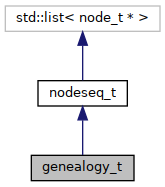
Public Member Functions | |
| size_t | ndeme (void) const |
| number of demes | |
| size_t & | ndeme (void) |
| number of demes | |
| size_t | bytesize (void) const |
| size of serialized binary form | |
| genealogy_t (double t0=0, name_t u=0, size_t nd=1) | |
| genealogy_t (raw_t *o) | |
| constructor from serialized binary form | |
| genealogy_t (SEXP o) | |
| constructor from RAW SEXP (containing binary serialization) | |
| genealogy_t (const genealogy_t &G) | |
| copy constructor | |
| genealogy_t & | operator= (const genealogy_t &G) |
| copy assignment operator | |
| genealogy_t (genealogy_t &&)=default | |
| move constructor | |
| genealogy_t & | operator= (genealogy_t &&)=default |
| move assignment operator | |
| ~genealogy_t (void) | |
| destructor | |
| slate_t & | time (void) |
| view/set current time. | |
| slate_t | time (void) const |
| view current time. | |
| slate_t & | timezero (void) |
| view/set zero time. | |
| slate_t | timezero (void) const |
| get zero time. | |
| void | lineage_count (double *tout, int *deme, int *ell, int *sat, int *etype) const |
| SEXP | lineage_count (void) const |
| lineage count and saturation | |
| void | gendat (double *tout, int *anc, int *lin, int *sat, int *type, int *index, int *child) const |
| nodelist in data-frame format | |
| SEXP | gendat (void) const |
| nodelist in data-frame format | |
| size_t | nsample (void) const |
| number of samples | |
| SEXP | structure (void) const |
| R list description. | |
| std::string | describe (void) const |
| human-readable info | |
| virtual std::string | yaml (std::string tab="") const |
| machine-readable info | |
| std::string | newick (void) const |
| put genealogy at current time into Newick format. | |
| void | valid (void) const |
| check the validity of the genealogy. | |
| bool | check_genealogy_size (size_t grace=0) const |
| check the size of the genealogy (to prevent memory exhaustion). | |
| node_t * | make_node (name_t d) |
| ball_t * | birth (ball_t *a, slate_t t, name_t d) |
| birth into deme d | |
| ball_t * | birth (node_t *p, name_t d) |
| birth of second or subsequent sibling into deme d | |
| void | death (ball_t *a, slate_t t) |
| death | |
| ball_t * | graft (slate_t t, name_t d) |
| graft a new lineage into deme d | |
| void | sample (ball_t *a, slate_t t) |
| insert a sample node | |
| void | sample_death (ball_t *a, slate_t t) |
| insert a sample node and simultaneously terminate the lineage | |
| ball_t * | migrate (ball_t *a, slate_t t, name_t d=0) |
| movement into deme d | |
| std::pair< node_it, node_it > | extant (void) const |
| genealogy_t & | prune (void) |
| prune the tree (drop all black balls) | |
| genealogy_t & | obscure (void) |
| erase all deme information | |
| void | curtail (slate_t tnew, slate_t troot) |
| genealogy_t & | operator+= (genealogy_t &G) |
| genealogy_t & | parse (const std::string &s, slate_t t0, node_t *p=0) |
| Parse a Newick string and create the indicated genealogy. | |
 Public Member Functions inherited from nodeseq_t Public Member Functions inherited from nodeseq_t | |
| ~nodeseq_t (void) | |
| destructor | |
| size_t | bytesize (void) const |
| size of serialized binary form | |
| nodeseq_t & | operator+= (nodeseq_t &other) |
| merge two node sequences | |
| void | sort (void) |
| order nodes in order of increasing time | |
| pocket_t * | colored (color_t col) const |
| Get all balls of a color. | |
| size_t | ntime (slate_t t) const |
| Number of distinct timepoints. | |
| size_t | length (void) const |
| Number of nodes in the sequence. | |
| node_t * | position (int n) |
| traverse to nth node, retrieve pointer | |
| void | swap (ball_t *a, ball_t *b) |
| swap balls a and b, wherever they lie | |
| void | add (node_t *p, ball_t *a) |
| void | drop (ball_t *a) |
| void | destroy_node (node_t *p) |
| remove a dead root node | |
| void | comb (void) |
| void | trace_lineages (void) |
| std::string | describe (void) const |
| human-readable info | |
| SEXP | structure (void) const |
| R list description. | |
| std::string | newick (slate_t t) const |
put genealogy at time t into Newick format. | |
Private Member Functions | |
| name_t | unique (void) |
| get the next unique name | |
| void | clean (void) |
| clean up | |
| size_t | scan_color (const std::string &s, color_t *col) const |
| size_t | scan_label (const std::string &s, color_t *col, name_t *deme, slate_t *time) const |
| size_t | scan_ball (const std::string &s, const slate_t t0, node_t *p) |
| size_t | scan_node (const std::string &s, const slate_t t0, node_t **q) |
| Scan the Newick string and create the indicated node. | |
| size_t | scan_tree (const std::string &s, const slate_t t0, node_t **root) |
Private Attributes | |
| name_t | _unique |
| The next unique name. | |
| slate_t | _t0 |
| The initial time. | |
| slate_t | _time |
| The current time. | |
| size_t | _ndeme |
| The number of demes. | |
Static Private Attributes | |
| static const name_t | magic = 1123581321 |
Friends | |
| raw_t * | operator>> (const genealogy_t &G, raw_t *o) |
| binary serialization | |
| raw_t * | operator>> (raw_t *o, genealogy_t &G) |
| binary deserialization | |
Detailed Description
Encodes a genealogy.
A genealogy consists of a sequence of nodes and the current time.
Definition at line 22 of file genealogy.h.
Constructor & Destructor Documentation
◆ genealogy_t() [1/5]
|
inline |
basic constructor for genealogy class t0 = initial time
Definition at line 105 of file genealogy.h.

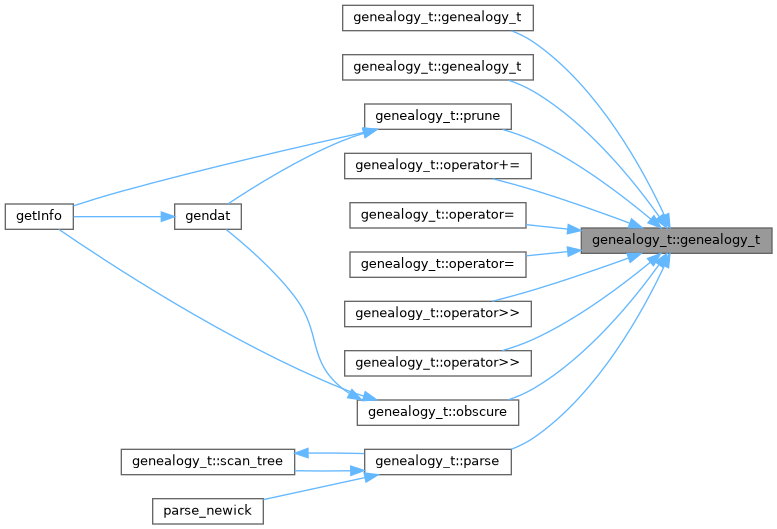
◆ genealogy_t() [2/5]
|
inline |
constructor from serialized binary form
Definition at line 112 of file genealogy.h.
◆ genealogy_t() [3/5]
|
inline |
constructor from RAW SEXP (containing binary serialization)
Definition at line 116 of file genealogy.h.
◆ genealogy_t() [4/5]
|
inline |
copy constructor
Definition at line 125 of file genealogy.h.

◆ genealogy_t() [5/5]
|
default |
move constructor

◆ ~genealogy_t()
|
inline |
Member Function Documentation
◆ birth() [1/2]
birth into deme d
Definition at line 404 of file genealogy.h.
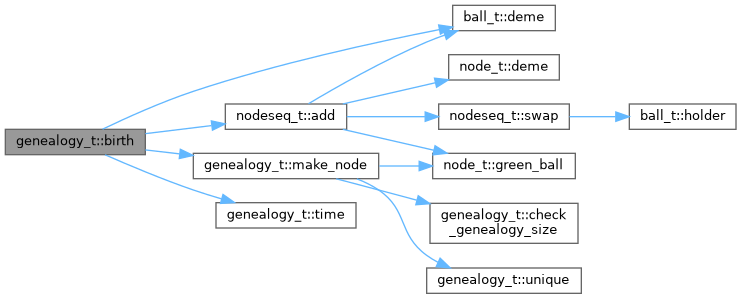
◆ birth() [2/2]
birth of second or subsequent sibling into deme d
Definition at line 414 of file genealogy.h.

◆ bytesize()
|
inline |
size of serialized binary form
Definition at line 73 of file genealogy.h.


◆ check_genealogy_size()
|
inline |
check the size of the genealogy (to prevent memory exhaustion).
Definition at line 376 of file genealogy.h.

◆ clean()
|
inlineprivate |
◆ curtail()
curtail the genealogy by removing nodes with times later than tnew and/or earlier than troot
Definition at line 499 of file genealogy.h.


◆ death()
death
Definition at line 420 of file genealogy.h.

◆ describe()
|
inline |
human-readable info
Definition at line 345 of file genealogy.h.

◆ extant()
set up for extraction of black balls (see 'inventory.h')
Definition at line 464 of file genealogy.h.

◆ gendat() [1/2]
|
inline |
nodelist in data-frame format
Definition at line 234 of file genealogy.h.


◆ gendat() [2/2]
|
inline |
nodelist in data-frame format
Definition at line 280 of file genealogy.h.


◆ graft()
graft a new lineage into deme d
Definition at line 425 of file genealogy.h.
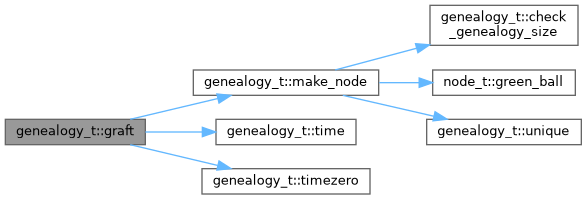
◆ lineage_count() [1/2]
|
inline |
lineage count, saturation, and event-type. types are:
- 0 = non-event
- -1 = root
- 1 = sample
- 2 = non-sample node
- 3 = end of interval
Definition at line 175 of file genealogy.h.

◆ lineage_count() [2/2]
|
inline |
lineage count and saturation
Definition at line 210 of file genealogy.h.


◆ make_node()
create a node holding its own green ball. insert into the genealogy.
Definition at line 391 of file genealogy.h.


◆ migrate()
◆ ndeme() [1/2]
|
inline |
◆ ndeme() [2/2]
|
inline |
number of demes
Definition at line 61 of file genealogy.h.

◆ newick()
|
inline |
put genealogy at current time into Newick format.
Definition at line 367 of file genealogy.h.

◆ nsample()
|
inline |
◆ obscure()
|
inline |
erase all deme information
Definition at line 479 of file genealogy.h.


◆ operator+=()
|
inline |
merge two genealogies:
- the node-sequences are merged;
- the root time retreats as necessary;
- the current time advances as necessary;
- the unique-name stack advances as necessary.
Definition at line 577 of file genealogy.h.

◆ operator=() [1/2]
|
inline |
◆ operator=() [2/2]
|
default |
move assignment operator

◆ parse()
|
inline |
Parse a Newick string and create the indicated genealogy.
Definition at line 737 of file genealogy.h.
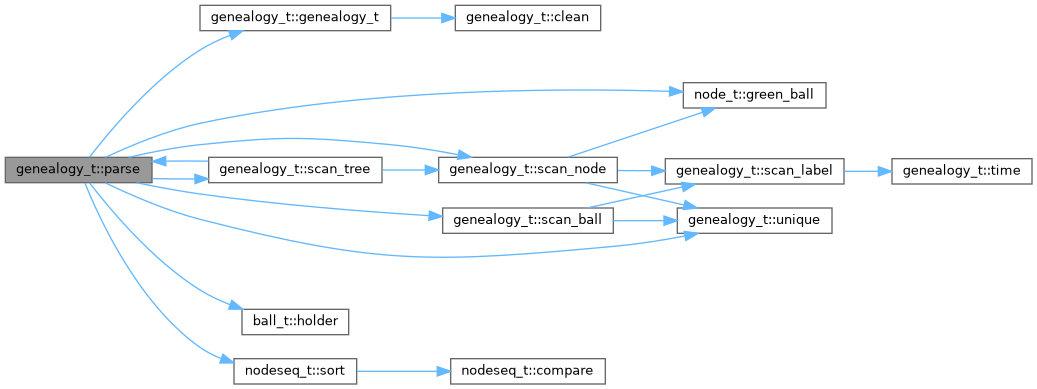

◆ prune()
|
inline |
prune the tree (drop all black balls)
Definition at line 468 of file genealogy.h.


◆ sample()
◆ sample_death()
insert a sample node and simultaneously terminate the lineage
Definition at line 444 of file genealogy.h.

◆ scan_ball()
Scan the Newick string and put the ball into the indicated pocket, as appropriate.
Definition at line 666 of file genealogy.h.


◆ scan_color()
|
inlineprivate |
Definition at line 588 of file genealogy.h.
◆ scan_label()
|
inlineprivate |
Scan the Newick-format label string. This has format c_d_d:f
Definition at line 593 of file genealogy.h.


◆ scan_node()
|
inlineprivate |
Scan the Newick string and create the indicated node.
Definition at line 682 of file genealogy.h.


◆ scan_tree()
|
inlineprivate |
Parse a single-root Newick tree. This assumes the string starts with a '('.
Definition at line 706 of file genealogy.h.


◆ structure()
|
inline |
R list description.
Definition at line 325 of file genealogy.h.

◆ time() [1/2]
|
inline |
view/set current time.
Definition at line 150 of file genealogy.h.
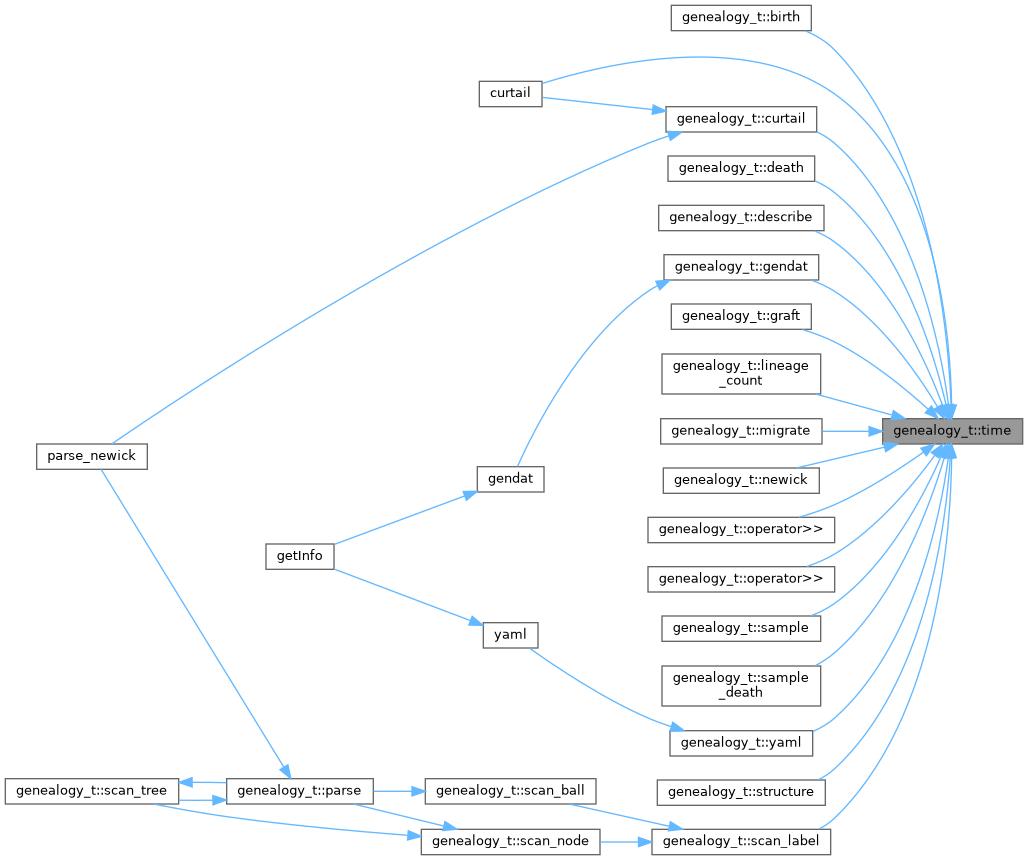
◆ time() [2/2]
|
inline |
◆ timezero() [1/2]
|
inline |
view/set zero time.
Definition at line 158 of file genealogy.h.
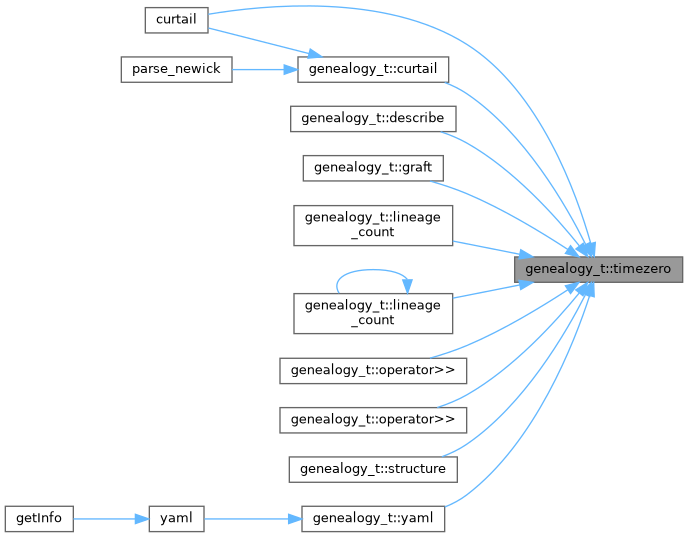
◆ timezero() [2/2]
|
inline |
◆ unique()
|
inlineprivate |
get the next unique name
Definition at line 46 of file genealogy.h.

◆ valid()
|
inline |
◆ yaml()
|
inlinevirtual |
machine-readable info
Reimplemented from nodeseq_t.
Definition at line 355 of file genealogy.h.


Friends And Related Symbol Documentation
◆ operator>> [1/2]
|
friend |
binary serialization
Definition at line 78 of file genealogy.h.
◆ operator>> [2/2]
|
friend |
binary deserialization
Definition at line 86 of file genealogy.h.
Field Documentation
◆ _ndeme
|
private |
The number of demes.
Definition at line 39 of file genealogy.h.
◆ _t0
|
private |
The initial time.
Definition at line 35 of file genealogy.h.
◆ _time
|
private |
The current time.
Definition at line 37 of file genealogy.h.
◆ _unique
|
private |
The next unique name.
Definition at line 33 of file genealogy.h.
◆ magic
|
staticprivate |
Definition at line 41 of file genealogy.h.
The documentation for this class was generated from the following file:
- src/genealogy.h






